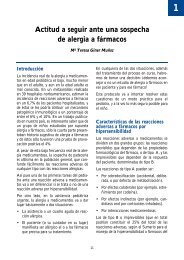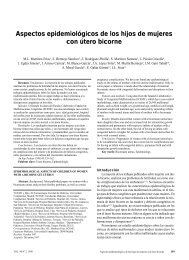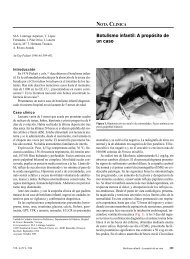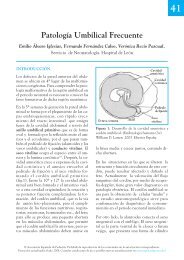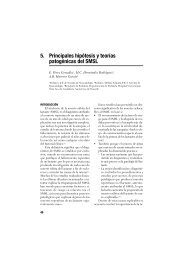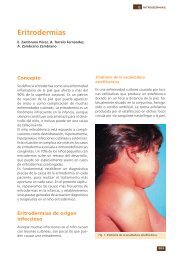Recomendaciones para el cuidado y atención del recién nacido ...
Recomendaciones para el cuidado y atención del recién nacido ...
Recomendaciones para el cuidado y atención del recién nacido ...
You also want an ePaper? Increase the reach of your titles
YUMPU automatically turns print PDFs into web optimized ePapers that Google loves.
muy bajo (A). Se recomienda la administración lo mas<br />
precoz posible (B) en formatos de unidosis (B).<br />
Todo RN debe ser correctamente identificado mediante un<br />
sistema de identificación que incluya datos d<strong>el</strong> RN y de su<br />
madre (B).<br />
El alta hospitalaria no debería realizarse antes de las 48 h<br />
de vida, si <strong>el</strong> nacimiento ha sido por parto vaginal, o tras<br />
72–96 h si es tras nacimiento por cesarea (B). Antes d<strong>el</strong> alta<br />
debe explorarse bajo la supervisión y responsabilidad de un<br />
especialista en Pediatría (B), y es recomendable una<br />
reevaluación a las 72 h d<strong>el</strong> nacimiento (B) e incluir <strong>el</strong> riesgo<br />
de desarrollar hiperbilirrubinemia.<br />
Bibliografía<br />
1. Documento de consenso SEGO de asistencia al parto 2007<br />
[citado 25 Ene 2009]. Disponible en: URL: http://www.sego.es/<br />
Content/doc/Documento_de_Consenso_y_<strong>Recomendaciones</strong>.<br />
doc.<br />
2. Canadian Task Force on Preventive Health Care. New grades for<br />
recommendations from the Canadian Task Force on Preventive<br />
Health Care. CMAJ. 2003;169:207–8.<br />
3. World Health Organization. Integrated management of pregnancy<br />
and childbirth (IMPAC), Provision of effective antenatal<br />
care, en Standards for maternal and neonatal care. World<br />
Health Organization; 2006.<br />
4. Sociedad Española de Obstetricia y Ginecología (SEGO).<br />
Sociedad Española de Neonatología (SEN). Sociedad Española<br />
de Enfermedades Infecciosas y Microbiología Clínica (SEIMC).<br />
Sociedad Española de Quimioterapia (SEQ). Sociedad Española<br />
de Medicina Familiar y Comunitaria (SEMFYC). Prevención de la<br />
infección perinatal por estreptococo d<strong>el</strong> grupo B. <strong>Recomendaciones</strong><br />
españolas revisadas. Enferm Infecc Microbiol Clin.<br />
2003;21:417–23.<br />
5. Comite de Estandares y Junta Directiva de la Sociedad Española<br />
de Neonatología. Niv<strong>el</strong>es asistenciales y recomendaciones<br />
de mínimos <strong>para</strong> la <strong>atención</strong> neonatal. An Pediatr (Barc).<br />
2004;60:56–64.<br />
6. Grupo de Reanimación Cardiopulmonar de la Sociedad Española<br />
de Neonatología. <strong>Recomendaciones</strong> en reanimación neonatal.<br />
An Pediatr (Barc). 2004;60:65–74.<br />
7. Buron Marinez E, Aguayo Maldonado J; Grupo de RCP Neonatal<br />
de la Sociedad Española de Neonatología. Reanimación d<strong>el</strong><br />
recien <strong>nacido</strong>. An Pediatr (Barc). 2006;65:470–7.<br />
8. Comisión de Estandares de la Sociedad Española de<br />
Neonatología. +Esta indicado realizar un lavado gastrico a los<br />
recien <strong>nacido</strong>s sanos?. An Pediatr (Barc). 2005;63:514–15.<br />
9. Apgar V. A proposal for a new method of evaluation of the<br />
newborn infant. Curr Res Anesth Analg 1953;32:260–7.<br />
10. Casey BM, McIntire DD, Leveno KJ. The continuing value of the<br />
Apgar score for the assessment of newborn infants. N Engl J<br />
Med. 2001;344:467–71.<br />
11. Johnson JW, Richards DS. The etiology of fetal acidosis as<br />
determined by umbilical cord acid-base studies. Am J Obstet<br />
Gynecol. 1997;177:274–80 discussion 280–2.<br />
12. Van den Berg PP, N<strong>el</strong>en WL, Jongsma HW, Nijland R, Kollee LA,<br />
Nijhuis JG. Neonatal complications in newborns with an<br />
umbilical artery pH, 7.00. Am J Obstet Gynecol. 1996;175:<br />
1152–1157.<br />
13. Royal College of Obstetricians and Gynaecologists Clinical<br />
Effectiveness Support Unit. The use of <strong>el</strong>ectronic fetal<br />
monitoring: The use and interpretation of cardiotocography in<br />
intrapartum fetal surveillance. London: RCOG, 2001. [citado 10<br />
Abr 2007]. Disponible en: URL: http://www.rcog.org.uk.<br />
ARTICLE IN PRESS<br />
Documento descargado de http://www.<strong>el</strong>sevier.es <strong>el</strong> 30/10/2009. Copia <strong>para</strong> uso personal, se prohíbe la transmisión de este documento por cualquier medio o formato.<br />
Cuidados d<strong>el</strong> recien <strong>nacido</strong> sano 359<br />
14. ACOG Committee Opinion N. o 348, November 2006: Umbilical<br />
cord blood gas and acid–base analysis. Obstet Gynecol.<br />
2006;108:1319–22.<br />
15. Armstrong L, Stenson BJ. Use of umbilical cord blood gas<br />
analysis in the assessment of the newborn. Arch Dis Child Fetal<br />
Neonatal Ed. 2007;92:F430–4.<br />
16. Estrategia de <strong>atención</strong> al parto normal en <strong>el</strong> Sistema Nacional<br />
de Salud. Ministerio de Sanidad y Consumo. Sanidad 2007<br />
[citado 25 Ene 2009]. Disponible en: URL: http://www.msc.es/<br />
organizacion/sns/planCalidadSNS/pdf/exc<strong>el</strong>encia/atencionPar<br />
to/estrategiaPartoEnero2008.pdf.<br />
17. WHO. Appropriate technology for birth. Lancet. 1985;2:436–7.<br />
18. WHO. Appropriate technology for birth revisited. Br J Obstet<br />
Gyneacol. 1992;99:709–10.<br />
19. Chalmers B. Who principles of perinatal care: The essential<br />
antenatal, perinatal, and postpartum care course. Birth.<br />
2001;28:202–7.<br />
20. Alberts JR. Learning as adaptation of the infant. Acta Paediatr<br />
Suppl. 1994;397:77–85.<br />
21. Moore ER, Anderson GC, Bergman N. Early skin-to-skin contact<br />
for mothers and their healthy newborn infants (review).<br />
Cochrane database of systematic Reviews 2007, art. N. o :<br />
CD003519. DOI:10.1002/14651858.CD003519.pub2 [citado 25<br />
Ene 2009]. Disponible en: URL: http://www.cochrane.org/<br />
reviews/en/ab003519.html.<br />
22. Righard L. Effect of d<strong>el</strong>ivery room routines on success of first<br />
breast-feed. Lancet. 1990;336:1105–7.<br />
23. Gómez Papi A, Baiges T, Batiste MT, Marca MM, Nieto A, Closa R.<br />
Metodo canguro en la sala de partos. An Esp Pediatr. 1998;48:<br />
631–633.<br />
24. Varendi H, Porter RH, Winberg J. Does the newborn baby find<br />
the nipple by sm<strong>el</strong>l?. Lancet. 1994;344:989–90.<br />
25. Mizuno K, Mizuno N, Shinohara T, Noda M. Mother-infant skin-toskin<br />
contact after d<strong>el</strong>ivery results in early recognition of own<br />
mother’s milk odour. Acta Paediatr. 2004;93:1640–5.<br />
26. Anderson GC, Chiu SH, Dombrowski MA, Swinth JY, Albert JM,<br />
Wada N. Mother-newborn contact in a randomized trial of<br />
kangaroo (skin-to-skin) care. Journal of Obstetric, Gynecologic<br />
and Neonatal Nursing. 2003;32:604–11.<br />
27. Bergman NJ, Linley LL, Fawcus SR. Randomized controlled trial<br />
of skin-to-skin contact from birth versus conventional incubator<br />
for physiological stabilization. Acta Paediatr. 2004;93:779–85.<br />
28. Chwo MJ, Anderson GC, Good M, Dowling DA, Shiau SH, Chu DM.<br />
A randomized controlled trial of early kangaroo care for<br />
preterm infants: Effects on temperature, weight, behavior,<br />
and acuity. Journal of Nursing Research. 2002;10:129–42.<br />
29. Syfrett EB, Anderson GC. Very early kangaroo care beginning at<br />
birth for healthy preterm infants and mothers who choose to<br />
breastfeed: effect on outcome. A workshop on the Kangaroomother<br />
method for low birthweigh infants. Trieste: World<br />
Health Organization; 1996.<br />
30. Erlandsson K, Dsilna A, Fagerberg I, Christensson K. Skin-to-skin<br />
care with the father after cesarean birth and its effect on<br />
newborn crying and prefeeding behavior. Birth. 2007;34:<br />
105–14.<br />
31. Hutton EK, Hassan ES. Late vs early clamping of the umbilical<br />
cord in full-term neonates: Systematic review and metaanalysis<br />
of controlled trials. JAMA. 2007;297:1241–52.<br />
32. McDonald SJ, Middleton P. Effect of timing of umbilical cord<br />
clamping of term infants on maternal and neonatal outcomes.<br />
Cochrane Database of Systematic Reviews 2008. CD004074.<br />
DOI:10.1002/14651858.CD004074.pub2.<br />
33. Jahazi A, Kordi M, Mirbehbahani NB, Mazloom SR. The effect of<br />
early and late umbilical cord clamping on neonatal hematocrit.<br />
J Perinatol. 2008;28:523–5.<br />
34. World Health Organization. Care of the umbilical cord. WHO/<br />
FHE/MSM-cord care. Geneva: WHO; 1998.



